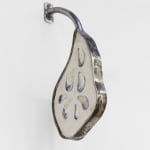


Tori Wrånes b. 1978
Mussel Tears, 2021
Steel, concrete, mussels
20.5 x 2 x 9.5 in
Further images
These objects, also the exhibition namesake, route the viewer through Kristiansand, Norway, a southern coastal fishing town and the Wrånes’ birthplace. She fondly remembers exploring the waters as a child...
These objects, also the exhibition namesake, route the viewer through Kristiansand, Norway, a southern coastal fishing town and the Wrånes’ birthplace. She fondly remembers exploring the waters as a child and expresses profound sadness about environmental degradation and the possible extinction of mussels that proliferated in this area. Known to ecologists as nature’s water filters, these mollusks play a principal role in maintaining a healthy ecosystem. Wrånes pays homage to these quiet heroes by creating droplet-shaped steel sculptures that mimic the mussels’ oblong shells, which also signify human tears. In these hand-forged frames, she incorporates the mollusks into cement, contrasting the formal qualities of the hard exterior shell with the iridescent interior, further likening them to the human body. Wrånes is interested in what we reveal and conceal, carefully considering the experience of a world outside of our bodies and within our minds.


